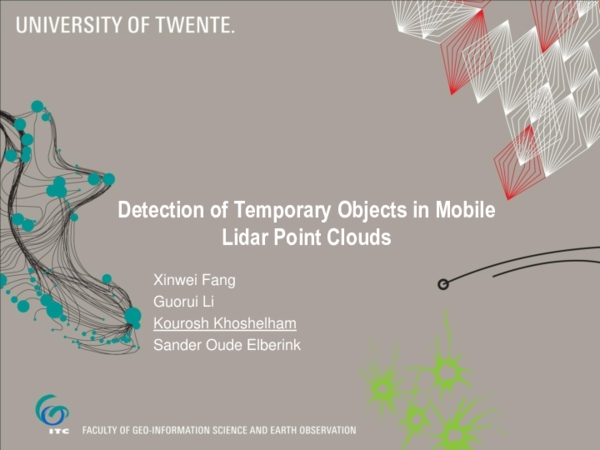Academia.edu no longer supports Internet Explorer.
To browse Academia.edu and the wider internet faster and more securely, please take a few seconds to upgrade your browser.
Detection of temporary objects in mobile Lidar point clouds
Detection of temporary objects in mobile Lidar point clouds
Related Papers
ISPRS Annals of Photogrammetry, Remote Sensing and Spatial Information Sciences
Extracting Mobile Objects in Images Using a Velodyne Lidar Point Cloud2015 •
This paper presents a full pipeline to extract mobile objects in images based on a simultaneous laser acquisition with a Velodyne scanner. The point cloud is first analysed to extract mobile objects in 3D. This is done using Dempster-Shafer theory and it results in weights telling for each points if it corresponds to a mobile object, a fixed object or if no decision can be made based on the data (unknown). These weights are projected in an image acquired simultaneously and used to segment the image between the mobile and the static part of the scene.
International Journal of Remote Sensing
Automated extraction of street-scene objects from mobile lidar point clouds2012 •
CEUR workshop proceedings
Robust methods for feature extraction from mobile laser scanning 3D point clouds2015 •
IEEE Geoscience and Remote Sensing Letters
A Skeleton-Based Hierarchical Method for Detecting 3-D Pole-Like Objects From Mobile LiDAR Point Clouds2019 •
ISPRS Annals of Photogrammetry, Remote Sensing and Spatial Information Sciences
Eigenvalue and graph-based object extraction from mobile laser scanning point clouds2013 •
IEEE Journal of Selected Topics in Applied Earth Observations and Remote Sensing
Voxel-Based Extraction and Classification of 3-D Pole-Like Objects From Mobile LiDAR Point Cloud Data2018 •
IEEE Transactions on Geoscience and Remote Sensing
Object Classification and Recognition From Mobile Laser Scanning Point Clouds in a Road Environment2015 •
IEEE Transactions on Geoscience and Remote Sensing
Semiautomated Extraction of Street Light Poles From Mobile LiDAR Point-Clouds2015 •
IEEE Geoscience and Remote Sensing Letters
Identifying man-made objects along urban road corridors from mobile lidar data2014 •
RELATED PAPERS
Yoruba Studies Review
Èdè Yorùbá, ọ̀rọ̀ àyálò, àti ọ̀rọ̀ àdàpọ̀ àti akẹ́kọ̀ọ́ kíkọ́ ní ìlú Amẹ́ríkà2021 •
2015 •
Brazilian Journal of Chemical Engineering
Optimizing dissolved air flotation design system2000 •
International Journal of Refrigeration
A phenomenological model for analyzing reciprocating compressors2007 •
Ponte sobre o Rio Cávado EN304 - km 76+626
Ponte sobre o Rio Cávado EN304 - km 76+6262008 •
Hand Therapy
Perceptions of preparedness and intimate partner violence screening practices amongst hand therapists2018 •
1983 •
2005 •
2004 •
2018 •
American Journal of Gastroenterology
Gastrointestinal Sounds and Migrating Motor Complex in Fasted Humans1999 •

 Kourosh Khoshelham
Kourosh Khoshelham